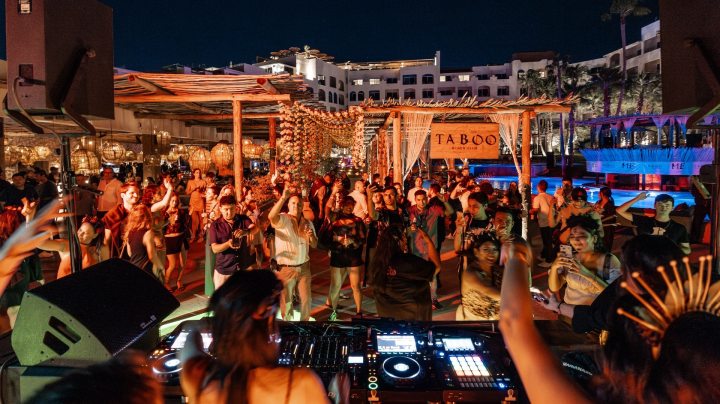Remezcla Tries: Dance of the Spirits Event at ME Cabo Resort

Courtesy of ME Cabo.
Remezcla Tries is where our editors put products, experiences, and trends to the test so you don’t have to. Whether it’s the latest beauty must-have, a viral experience, or a cultural phenomenon, we’re here to give you the real scoop. Consider this your intel from your go-to Latine editors to decide what’s worth your time, money, and energy—straight from those who’ve tried it firsthand.
Despite growing up in Tijuana, Mexico, I never celebrated Día de los Muertos at home. Sure, it’s part of the school curriculum — teachers would set up an altar, students would color and decorate a paper skeleton in Catrina or Catrín wardrobe, and maybe even write a calaverita — but it never translated to my home. My family remembered our dead by going to church on anniversaries and offering a mass for them, but that was it. Día de los Muertos was generally a normal day for me — until my grandma passed away. In my early 20s, my cousins adopted setting up an ofrenda for her, a tradition we never learned from her but took up to honor her memory. I, on the other hand, succumbed to the “I’m busy” excuse and didn’t follow suit. It’s hard to follow a tradition you never practiced in the first place.
Though Día de los Muertos has become a part of the mainstream consciousness in the U.S. in part thanks to the movie Coco, I’ve heard from many friends that they also never celebrated the holiday growing up. Maybe it’s a Northern Mexico-frontera thing. With no deeply rooted sentimental ties to Nov. 2, the idea of going to ME Cabo Resort in Cabo San Lucas in Mexico seemed like an interesting opportunity. The resort was hosting its inaugural Día de los Muertos event, A Night to Remember ME Vol 1: Dance of the Spirits. Aimed to “honor rich traditions and offer a truly unparalleled journey into the heart of the destination in a contemporary way,” as Director of Marketing & Brand Development Americas Sara Ranghi said, the event would feature performances by acclaimed American violinist Ezinma and top Mexican DJ Mariana Bo and highlight the holiday’s traditions.
With a bit of hesitation over the commercialization — and gringo-fication — of the Day of the Dead and a lot of journalistic curiosity, I thought to myself, “Día de los muertos is a celebration; why not take it literally?” So on the eve of her 60th birthday, I invited my mom to join me on the trip, who reminded me that Cabo was the first vacation we ever took with my dad when I was 6 months old. It was her first time back, and we were doing it together as a family again. The only difference was my dad’s absence, who passed away 27 years ago.

First Impressions
Overlooking the Sea of Cortez and a desktop background-worthy shot of El Arco, walking into ME Cabo is breathtaking. It has all the amenities you’d want from a resort: restaurant variety, bar in the pool, beach access, complimentary slippers in the room, and amazing cocktails. Heavy on the delicious cocktails. The hotel alone, located close to downtown Cabo San Lucas, is worth the trip. But we were there for a special occasion — Dance of the Spirits.
Hosted on Nov. 2 at the resort’s restaurant and beach club Taboo, the event was open to hotel guests and outside patrons alike with a reservation. Upon entering the hotel’s pool area, Catrinas and Catrines greeted you, gifting you a hand fan and headpiece for women and a moño for men’s shirts. On the side of the stairs, the organizers set up an ofrenda, which attendees could email their deceased loved one’s pictures to be added. To complete the look, guests could book appointments with makeup artists for the sugar candy skull look. As you walked into Taboo, marigolds showered down the dimly lit pathway, providing a stunning backdrop to the dinner. Though the restaurant’s menu skewed Mediterranean, the variety of mezcal and tequila drinks fueled a beautiful night soundtracked by a dynamic performance by Ezinma and a booming set by Mariana Bo.
The Best Part
I’m well past clubbing age, but when I’m on vacation, having an event to get dolled up to is exciting. More than a cultural event, Dance of the Spirits was more like a themed dinner-club soirée. It was not the type of party where you could talk to people; it was a dinner and a show, complete with fire dancers and fireworks soundtracked to “New York, New York.” The cultural elements adorned the event, which was a tasteful way of honoring and acknowledging the night in a fun way.

Besides the Día de los Muertos event, the resort offered many relaxing options. Whether on a chaise at the beach with a michelada on hand, sweating out the toxins in the sauna, or even taking the complimentary boat trip to El Arco and seeing marine life, the opportunities to unwind were plenty. And with my job, this was more necessary than I initially anticipated.
The Not-So-Best Part
As already mentioned, I am a Mexican who grew up in Mexico, and because of that, I have a Mexican palette. It’s a blessing but also my toxic trait. Having tried most of the restaurants at ME Cabo, I got the sense that the menus were mostly crafted with foreign tourists in mind. It makes sense, given that Cabo is mostly an American tourist destination. While I’m no expert, food is central to my vacation experiences. At ME Cabo, I often found myself altering my dishes to fit my preferences – lime to the guacamole and ceviches, spicy salsa to the chilaquiles, and salt to almost everything, including the steaks and pasta. This led me to eat mostly at the Asian fusion restaurant; they weren’t that experimental with fire noodles and crab rangoons, and for that, I was happy. I grew disappointed in originally spicy dishes, like aguachile or chilaquiles, be sweet instead, or most dishes, like avocado toast, have feta cheese. Para gustos, los colores, of course. But like most dishes I had at the resort, this opinion should be taken with a grain of salt.
Final Thoughts
Dance of the Spirits is not for everyone. If you are a person who celebrates Día de los Muertos by going to the panteón to visit your loved one or gather with family for an at-home dinner in honor of the departed, this event might not resonate with you. This event is mainly aimed at foreign tourists who want to experience some of the cultural signifiers of the holiday, as well as those of Mexican descent who don’t have generational ties to it — like me. But I look at the full picture rather than just focusing on the event. While the themed party was supposed to be the main attraction, looking at the entire weekend, I ended up celebrating Día de Muertos in an unexpected way.
What are traditions if not a set of customs or beliefs that one generation starts and then passes on to the next? Friendsgiving and Galentine’s are new interpretations of established traditions. And just like the tradition of traveling to Las Vegas to celebrate Mexican Independence Day, why can’t Día de los Muertos be reinterpreted? Culture doesn’t stay stuck in a time capsule; it evolves and changes with time. Just take the Día de los Muertos parade: it started with a James Bond movie, and locals liked the idea so much that they adopted it and made it an annual event.
Does this mean I’ll be going to Cabo every year with my mom for Día de los Muertos? Probably not, but the experience showed me that there are many ways to celebrate our deceased loved ones, and they don’t have to be tied to a specific place. While lounging at the beach, my mom told me stories about that trip we took with my dad all those years ago, what he drank, and the foods and the music he liked. Usually, talking about my dad leads to sad stories, but here, the conversations were full of laughter and joy that highlighted the good times.
I now have a new memory I can one day tell the next generation in my family: returning to Cabo with my mom, the place where we took our first vacation as a family together, and remembered my dad. It’s a happy one and a welcomed one. Which, in my opinion, embodies what Día de los Muertos is really about.
Travel and accommodations were provided to the author by ME Cabo for the purpose of writing this story.